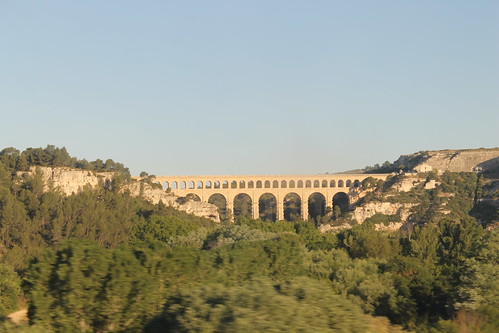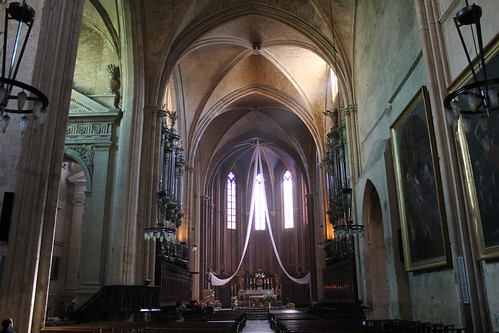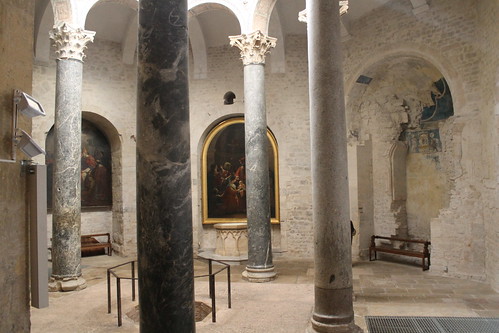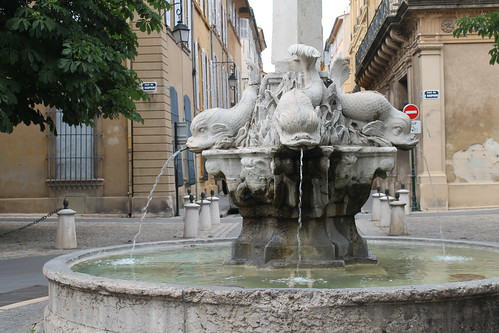On Monday, we took a train just an hour and a half south for a day trip to Aix-en-Provence, in the Provence-Alpes-Côte-d’Azur region of France. One of my favorite things about visiting Europe is that I get to see many of things I learned about in my six years of studying Latin in high school. I first learned about Aix, as it is nicknamed, as the Roman city of Aquae Sextiae, founded in 123 BC after a heated battle by the Romans against the Teutones and Cimbri, two prominent Germanic tribes. The city is geographically positioned practically on the Mediterranean coast, a stone’s throw from Marseille, and about 300 kilometers directly south of Lyon. We’ve been in Lyon for nearly a month now, so it was about time we got to see another part of France!

We boarded a TGV train at Lyon Perrache that left the city at the hazy grey hour of 6 am. We couldn’t really sleep very well, as the morning sun only got brighter on our journey down to Aix. Fortunately, I had given up on sleep and was raptly gazing out the window when we went past the Roquefavour aqueduct, which looks absolutely amazing, and managed to grab a non-blurry photo! It’s neat, though not quite as impressive as the Pont du Gard aqueduct, but we may get to see that! Next, we took a bus from the Aix-en-Provence TGV station into town, and set off on a long rambling walk around the city.

The main thoroughfare of Aix, a city that holds a paltry 143,000 residents, is the Cours Mirabeau, a wide road bordered by tall plane trees and punctuated by four fountains, for which Aix is renowned. La Rotonde is the biggest fountain at its southern end, obviously more of a recent addition as it reposes at the center of a traffic circle, and the two to the north are significantly older, as you can tell by the mossy vegetation they are covered in. One of them even runs warm water, drawn from the hot springs that Aix was originally named for.


We stopped at each fountain, munching the pastry we bought from a nearby shop, and slowly meandered up the street. Steve had done most of the research on Aix, and thoughtfully pointed out to me landmarks like Les Deux Garçons, a famous brasserie founded in 1792, frequented by the likes of Émile Zola and Paul Cezanne. Cezanne in particular is someone Aix is very proud of, having done many of his paintings on the surrounding countryside of Provence. We even encountered a statue of Cezanne across from La Rotonde, looking much less like an anemic French painter and much more like a cross between Hemingway and Paul Bunyan. All right, you decide for yourself!

Each street we encountered seemed to be more narrow than the last, and fountains cropped up in small squares and intersections everywhere we looked. We finally found what we were looking for: the Aix Cathedral, also known as the Cathédrale de Saint-Sauveur. I have been subjected to many churches and cathedrals all over Austria, Hungary, France, the Czech Republic, and most recently, Croatia, but I have to say my favorite has got to be the Aix Cathedral. Not even the crowd of chattering visor-wearing Japanese tourists who entered after us could dampen my enthusiasm for this place! It is the most harmonious mix of architectural styles, having been built on an old Roman forum, and expanded over the years to include a cloister, a baptistery that used to be a 6th century Christian church, and much more. You can see the walls of where the old arches were filled in, and in the baptistery, there are exposed fragments of a fresco from the 14th century, telling the story of St. Francis of Assisi and St. Claire, as well as a mosaic which dates from the 6th century! We stayed for nearly an hour admiring its every nook and cranny. The most beautiful part was definitely the cloister, which enclosed a tiny courtyard and garden with its very graceful old columns, and provided a glimpse of how this hodgepodge of architecture looked from the outside. Both of us were very taken with the entire character and atmosphere of the cathedral, and agreed that this was among the best we’ve seen.




After the Aix Cathedral, we grabbed a few sandwiches, had an unfortunate and long search for a public bathroom, and finally made it to the Parc Jourdan, to the southwest of the Cours Mirabeau, for our lunch al fresco! We also took turns napping, and somewhere during that lazy afternoon, I also did a watercolor painting of the park, having brought along my materials. Eventually, we got going again to take a look at a few more sights. One was the Église de Sainte-Jean-de-Malte, a Catholic church constructed by the Order of Malta. I do love going to churches with someone who has a degree in medieval theology! I tend to know more of the Latin, but Steve knows the Biblical stories much better. He spent a lot of time describing some of the stained glass windows, which depict the meeting of Jesus and John the Baptist, as well as some of the really lovely art around the otherwise slightly lonely church.

Afterwards, we headed back to the Cours Mirabeau, making a quick stop at the Fountain of the Four Dolphins, one of the most well-known fountains in Aix. We liked this whimsical fountain so much we bought a postcard of it to keep as a momento. Then we found a place to enjoy a quick coffee and people-watch for an hour. Aix as a city is far more touristy than Lyon, but maybe that’s because we stay in a relatively tourist-free quarter. Without provocation, the waiters spoke English to us, which is almost a let down after how much Steve and I have been working on our French! Finally, we got back to the TGV station and boarded a very busy and packed train back to Lyon, which was rainy and dark.

Looking at a globe (or more realistically, Google Maps!), it’s easy to place your finger on a country and think of a single identity like China, with hallmarks of chopsticks, dumplings, and the Forbidden Palace. Travel has helped us come face to face with the regional variations within a nation-state and better understand the overlapping areas of culture, language, tradition, religion, and more which are not defined on a map but nevertheless cross national borders. When we took a train from New Delhi to Kochi in India, we began to see signs and newspapers in Malayalam, one of the languages of the south, written in a completely different script from Hindi, and it was but just one reminder that India encompasses dozens of peoples, languages, and just as many traditions. The same is true even of a small hexagon like France. The traditional language of Aix-en-Provence is not French but Provençal, a dialect of the Occitan language. Occitan itself is a Romance language spoken in northern Spain, southern France, and northern Italy, and is very closely related to Catalan. Accordingly, anyone familiar with Romance languages would be able to identify elements of French, Spanish, and Italian from words of Occitan. Like many languages which are not the official state language, however, Provençal Occitan is rapidly disappearing from popular usage. We saw its remnants however on building corners, where street signs are displayed in both Provençal Occitan and French.

Overall, we really liked Aix, although our 14-hour day trip was obviously a strain on both of us. The next day, we both slept late and mostly moped around the house, but that may have been because it was unseasonably rainy and damp in Lyon. Yesterday and today, the sun has come back, and Steve and I are busy with our respective projects and with preparing for our trip next week to southwestern France, Barcelona, and Paris, with our friend Lele from Chicago. It feels like June is almost upon us, though I’ve barely gotten used to the idea of May! I promise to write more soon about our adventures in the hexagon.
Connie